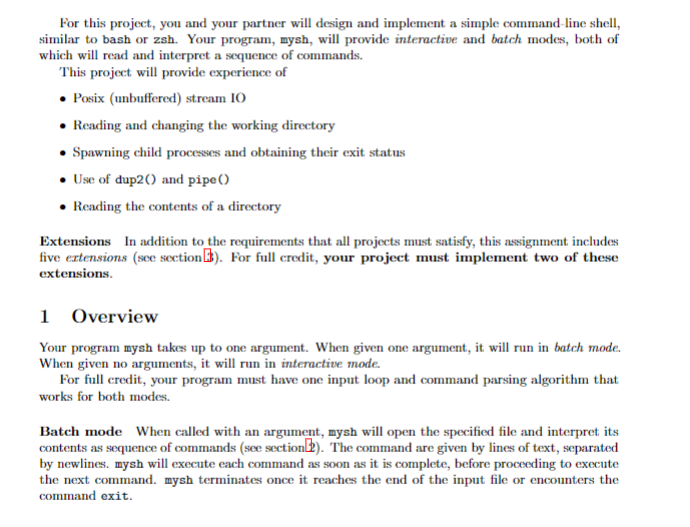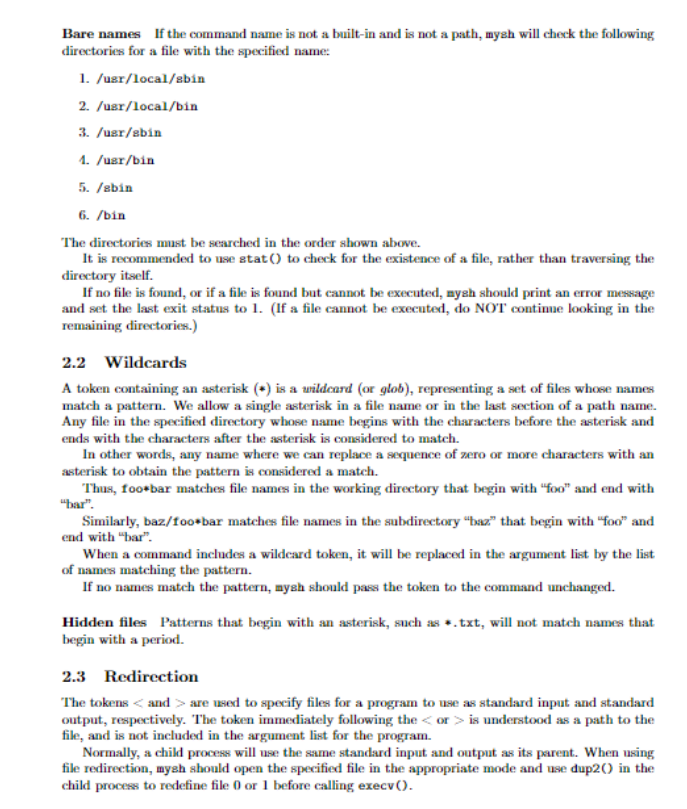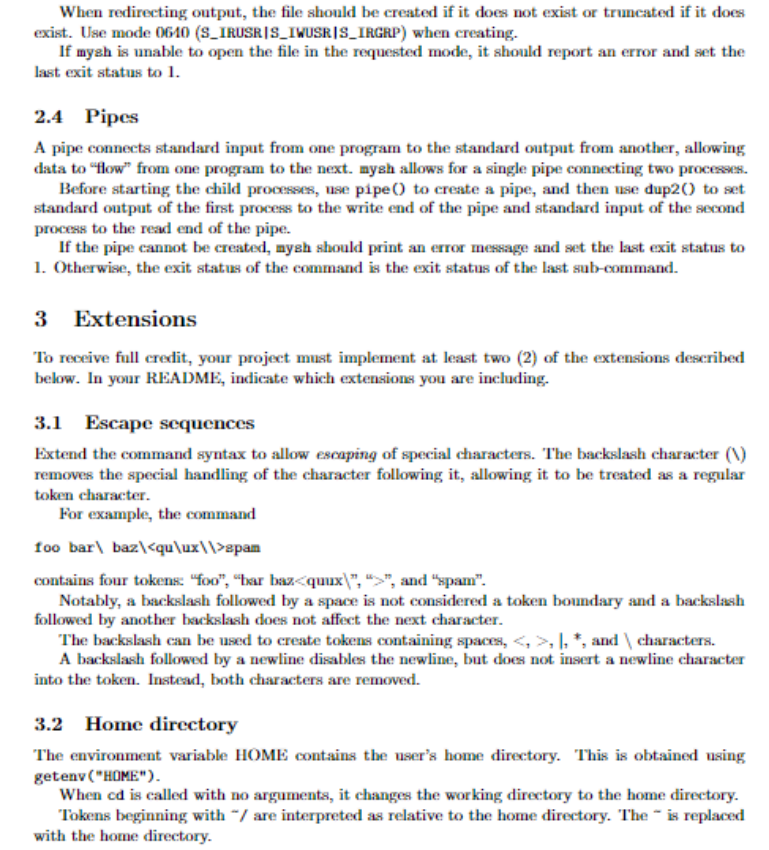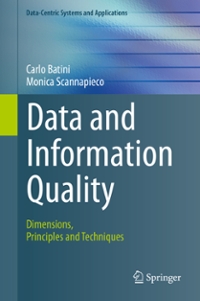Question
our program mysh takes up to one argument. When given one argument, it will run in batch mode. When given no arguments, it will run
our program mysh takes up to one argument. When given one argument, it will run in batch mode. When given no arguments, it will run in interactive mode. For full credit, your program must have one input loop and command parsing algorithm that works for both modes. Batch mode When called with an argument, mysh will open the specified file and interpret its contents as sequence of commands (see section 2). The command are given by lines of text, separated by newlines. mysh will execute each command as soon as it is complete, before proceeding to execute the next command.






Explain in C code please
For this project, you and your partner will design and implement a simple command-line shell, similar to bash or zsh. Your program, mysh, will provide interactive and batch modes, both of which will read and interpret a sequence of commands. This project will provide experience of - Posix (unbuffered) stream IO - Reading and changing the working directory - Spawning child processes and obtaining their exit status - Use of dup2() and pipe() - Reading the contents of a directory Extensions In addition to the requirements that all projects must satisfy, this assignment includes extensions. 1 Overview Your program mysh takes up to one argument. When given one argument, it will run in batch mode. When given no arguments, it will run in interactive mode. For full credit, your program must have one input loop and command parsing algorithm that works for both modes. Batch mode When called with an argument, mysh will open the specified file and interpret its contents as sequence of commands (see sectionW2). The command are given by lines of text, separated by newlines. mysh will execute each command as soon as it is complete, before proceding to execute the next command. mysh terminates once it reaches the end of the input file or encounters the command exit. Interactive mode When called with no arguments, mysh will read commands from standard input. Before reading a command, mysh will write a prompt to standard output. After executing the command, mysh will print a new prompt and read the next command. To ensure that prompts are printed appropriately, mysh must be careful not to call read( ) again if a newline character has already been entered. aysh terminates once it reaches the end of the input file or encounters the command exit. In this mode, nyeh should print a greeting before the first prompt and a message when terminating normally. "The format of these are left to you. Prompt format When running in interactive mode, mysh will print a prompt to indicate that it is ready to read input. The prompt is normally the string "mysh > " (note the trailing space). If the last command failed (mesaing its exit status was non-zero), the prompt is the string: "?mysh > " (that is, it is preceded by an exclamation point). Usage Batch mode: $ cat myecript. sh echo hello \$./ah nyacript. ah hello $ Interactive mode: 5./myah Welcome to my ahel1! myah> cd aubdir myah> echo hello hello myah> cd abbeubdir myah> pod /current/path/abdir/aubeubdir mysh> cd directory_that_does_not_exist cd: No auch file or directory Iayah> cd.../.. /current/paths exit mysh: exiting $ Note the exclamation point after a failed command. 2 Command format A mysh command comprises one or more tokens. 'Tokens are sequences of non-whitespece characters, and are usually separated by whitespace. The exceptions are 1,, which are considered tokens by themselves. "Thus, a string foo bar2.11 ). The tokens introduce file redirection (see section 2.3 ). 'okens containing an asterisk (*) stand for a sequence of file names matching the given pattern (secsection2.2). 'The command's tokens, excluding file redirection sequences and with wildcards replaced, become the arguments to the command (usually a subprocesses). For example, this command foo bar > span executed in a directory containing files bacon.txt and eggs.txt would result in the execution of two programs, foo and quux, where: - foo receives the arguments "foo" and "bar" - quux receives the arguments "quux", "bacon.txt", and "eggs.txt" - foo has standard input set to the file "bar" - quux has standard output set to the file "pam" - foo has standard outpat sent to a pipe and quux has standard input set to the other end of the same pipe There is no intrinsic limit to the length of a command. 2.1 Command name The first token of a command (or sub-command) indicates the program or built-in operation to execute. Built-in commands 'The commands cd and pud are provided by mysh directly. Their purposes are to change and print the current working directory, respectively. "The standard library includes functions chdir ( ) and getcud () for these purposes. cd takes a single argument, a path indieating the new working directory. pud takes no arguments. In the event of an error (such as changing to a non-existant or inaccessible directory), mysh should print an error message (preferably using perror ( ) or strerror () ) to standard error and set the last exit status to 1. Path names If the first token contains a slash (/), it represents a path to an executable program. mysh should use fork () to create a subprocess, execv ( ) to execute the specified program (providing arguments), and wait () to obtain the program's exit status. If the specified program cannot be executing, mysh should print an error message and set the last exit status to 1 . Bare names If the command name is not a built-in and is not a path, mysh will check the following directories for a file with the specified name: 1. /usr/local/sbin 2. /usr/local/bin 3. /ugr/sbin 1. /usr/bin 5. /sbin 6. /bin The directories must be searched in the order shown above. It is recommended to use stat () to check for the existence of a file, rather than traversing the directory itself. If no file is found, or if a file is found but cannot be executed, nysh should print an error message and set the last exit status to 1. (If a file cannot be executed, do NOT continue looking in the remaining directories.) 2.2 Wildcards A token containing an asterisk (*) is a wildcard (or glob), representing a set of files whose names match a pattern. We allow a single asterisk in a file name or in the last section of a path name. Any file in the specified directory whose name begins with the characters before the asterisk and ends with the characters after the asterisk is considered to match. In other words, any name where we can replace a sequence of zero or more characters with an asterisk to obtain the pattern is considered a match. 'Thus, foo*bar matches file names in the working directory that begin with "foo" and end with "bar". Similarly, baz/foo*bar matches file names in the subdirectory "baz" that begin with "foo" and end with "bar". When a command includes a wildeard token, it will be replaced in the argument list by the list of names matching the pattern. If no names match the pattern, mysh should pass the token to the command unchanged. Hidden files Patterns that begin with an asterisk, such as *.txt, will not match names that begin with a period. 2.3 Redirection The tokens are used to specify files for a program to use as standard input and standard output, respectively. The token immediately following the is understood as a path to the file, and is not included in the argument list for the program. Normally, a child process will use the same standard input and output as its parent. When using file redirection, mysh should open the specified file in the appropriate mode and use dup2() in the child process to redefine file 0 or 1 before calling execv(). When redirecting output, the file should be created if it does not exist or truncated if it does exist. Use mode 0640 (S_IRUSR|S_IWUSR|S_IRGRP) when creating. If mysh is unable to open the file in the requested mode, it should report an error and set the last exit status to 1. 2.4 Pipes A pipe connects standard input from one program to the standard output from another, allowing data to "flow" from one program to the next. mysh allows for a single pipe connecting two processes. Before starting the child processes, use pipe() to create a pipe, and then use dup2() to set standard output of the first process to the write end of the pipe and standard input of the second process to the read end of the pipe. If the pipe cannot be created, mysh should print an error message and set the last exit status to 1. Otherwise, the exit status of the command is the exit status of the last sub-command. 3 Extensions To receive full eredit, your project must implement at least two (2) of the extensions described below. In your README, indicate which extensions you are including. 3.1 Escape sequences Eixtend the command syntax to allow escaping of special characters. The backslash character ( ) removes the special handling of the character following it, allowing it to be treated as a regular token character. For example, the command contains four tokens: "foo", "bar bazStep by Step Solution
There are 3 Steps involved in it
Step: 1

Get Instant Access to Expert-Tailored Solutions
See step-by-step solutions with expert insights and AI powered tools for academic success
Step: 2

Step: 3

Ace Your Homework with AI
Get the answers you need in no time with our AI-driven, step-by-step assistance
Get Started


